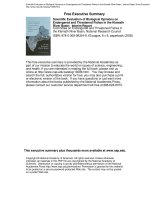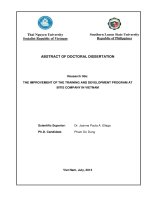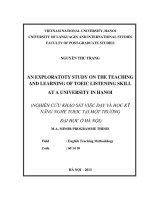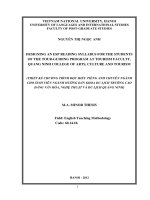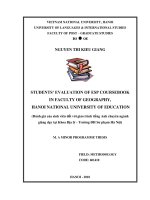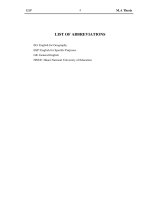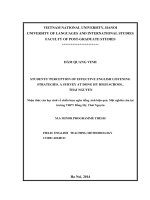English-as-a-medium-of-instruction students’ evaluation of an English foundation program at a university in Vietnam
Bạn đang xem bản rút gọn của tài liệu. Xem và tải ngay bản đầy đủ của tài liệu tại đây (221.54 KB, 8 trang )
<span class='text_page_counter'>(1)</span><div class='page_container' data-page=1>
<i>DOI: 10.22144/ctu.jen.2018.021 </i>
<b>English-as-a-medium-of-instruction students’ evaluation of an English foundation </b>
<b>program at a university in Vietnam </b>
Phuong Hoang Yen*<sub>, Huynh Chi Minh Huyen and Nguyen Hai Quan </sub>
<i>School of Foreign Languages, Can Tho University, Vietnam </i>
<i>*<sub>Correspondence: Phuong Hoang Yen (email: ) </sub></i>
<b>Article info. </b> <b> ABSTRACT </b>
<i>Received 28 Oct 2017 </i>
<i>Revised 04 Dec 2017 </i>
<i>Accepted 20 Jul 2018</i>
<i><b> With the growing popularity of English-as-a-medium-of-instruction (EMI) </b></i>
<i>all over the world, the issue of how to best prepare non-native students for </i>
<i>their language-related problems in EMI courses also arises. While a </i>
<i>num-ber of studies have shed critical light on problems students encounter in </i>
<i>EMI courses, very few have explored how students should be supported to </i>
<i>overcome these challenges. The current study was conducted to investigate </i>
<i>such an effort in a university in Vietnam where an English foundation </i>
<i>pro-gram (EFP) of 390 hours have been designed and implemented for one </i>
<i>semester before students begin their EMI courses. In particular, the study </i>
<i>was aimed to figure out the structure of the EFP and students’ evaluation </i>
<i>of its usefulness for their EMI courses. The findings from the current study </i>
<i>reveal that the EFP was carefully designed to tailor students’ needs of </i>
<i>Eng-lish proficiency enhancement for EMI courses, but only half of the student </i>
<i>participants found that that the program was helpful to their EMI courses. </i>
<i>Consequently, the study provided the EFP designers with a basis to further </i>
<i>improve their program and to help other institutions which are </i>
<i>implement-ing EMI have an idea of what should be done to support their students. </i>
<i><b>Keywords </b></i>
<i>EMI, foundation, support </i>
Cited as: Yen, P.H., Huyen, H.C.M. and Quan, N.H., 2018. English-as-a-medium-of-instruction students’
evaluation of an English foundation program at a university in Vietnam. Can Tho University
<i>Journal of Science. 54(5): 30-37. </i>
<b>1 INTRODUCTION </b>
While English as a medium of instruction (EMI) has
attracted various researchers in conducting studies
on its impact, benefits, and challenges, few studies
have been done to investigate how different
institutions around the world are helping their
teachers and students be prepared for
language-related problems that they will deal with in their
classrooms. Meanwhile, problems such as teachers’
and students’ inadequate English language
proficiency (ELP), mixed entrance ELP, students’
lack of field-specific lexis have prevented students
from gaining sufficient knowledge and deep
understanding of EMI courses. Several measures
</div>
<span class='text_page_counter'>(2)</span><div class='page_container' data-page=2>
<b>2 LITERATURE REVIEW </b>
<b>2.1 The EMI approach </b>
EMI, with its increasing popularity, has become a
worldwide educational trend. However, the
educational characteristics and policies regarding
EMI vary from context to context. In the same vein,
the term EMI has been defined differently by
various researchers, who seem not to reach a
consensus up to date. According to Dearden (2014),
EMI is ‘the use of the English language to teach
academic subjects in countries or jurisdictions
where the first language (L1) of the majority of the
population is not English’ (p. 4). From this
perspective, EMI can be considered synonymous to
Content and Language Integrated Learning (CLIL).
However, while CLIL aims at developing both the
content and language as its name suggests, EMI has
its reference to the approach for which English is
used to teach academic subjects in contexts where
English is not the mother tongue or the second
language. In this way, no explicit language learning
objectives are officially set for EMI, and the focus
of EMI is acquiring the content, academic or
subject-related knowledge.
<b>2.2 Students’ language related problems in </b>
<b>EMI courses </b>
Several language-related problems arise for students
in EMI courses. These include students’ low
entrance English proficiency level, their lack of
field-specific lexis and academic reading and
writing skills, and mixed English-level classes,
which prevent EMI students from gaining sufficient
knowledge and deep understanding of the EMI
courses.
Regarding the students’ entrance ELP, Williams
(2015) with a systematic review of the global
published research on EMI implementation in
higher educational contexts reveals that the role of
the English proficiency of students and instructors
and the varying requirements of academic subjects
towards the success of the EMI programs have been
underscored. Consequently, low English level of
students in EMI classroom has been reported to
cause detrimental effects on students’ academic and
<i>mental lives (Doiz et al., 2011; Tatzl, 2011; Başıbek </i>
<i>et al., 2014; Dearden, 2014; Barrios et al., 2016 ). </i>
Doiz et al. (2011) and Lau and Yuen (2011) argue
that it is students’ poor command of English that
causes negative effects on the students’ academic
performance and their participation in EMI
classroom.
With regard to students’ lack of field-specific lexis
and academic reading and writing skills, Belhiah
and Elhami (2015) figured out that most Arabian
students in their study did not have the appropriate
reading, writing or speaking skill for understanding
course materials, answering exam questions in
English, or communicate effectively during
classroom activities. The researchers highlighted
that the English students used was not very
academic and their ability to interact in English was
just at basic level. Likewise, in the study of Tatzl
(2011), the lecturers and students at an Austrian
university of applied sciences confirmed that EMI
poses linguistic challenges to them. Among the four
skills of English, speaking and writing are the most
challenging ones as perceived by both Austrian
teachers and students. In the same vein, the Turkish
lecturers (n=63) at two universities in Turkey which
are currently offering partial EMI, i.e. one third of
the lectures in English, the others in Turkish,
perceived that teaching in Turkish would facilitate
the depth and more comprehension with respect to
the lesson content than teaching in English (Başıbek
<i>et al., 2014). </i>
Indeed, the various English abilities and low English
proficiency of EMI learners have presented
obstacles to the teaching as well as the
implementation of curriculum in most EMI contexts
<i>(Doiz et al., 2011; Tatzl, 2011; Dearden, 2014; </i>
<i>Alhamami, 2015; Barrios et al., 2016 ). According </i>
to these authors, EMI teachers have devoted a good
deal of time and effort for explaining, repeating the
information, or preparing materials, which means
that they cannot cover all the required topics during
the semester.
</div>
<span class='text_page_counter'>(3)</span><div class='page_container' data-page=3>
Hong Kong. The results indicated that the academic
performance of Chinese-medium instructed students
was higher than that of the English-medium
instructed students, and the middle and low-ability
students in English-medium schools were placed at
a disadvantage. Similarly, the science lecturers in
Channa's (2012) study expressed their negative
attitudes towards the EMI approach in that it is not
beneficial for learners coming from different types
of backgrounds and mediums which imply a variety
in students’ English proficiency.
In short, EMI students have to encounter various
language-related problems which should be
addressed thoroughly to help them gain success in
their EMI courses.
<b>2.3 English foundation programs for EMI </b>
In order to help EMI students solve language-related
problems, different measures have been
implemented, and probably the most common one is
setting a certain level of ELP as a threshold for EMI
courses (Saarinen and Nikula, 2013; Wilkinson,
2013; Hu and Lei, 2014). This threshold is expected
to help screen out students who were not sufficiently
prepared in term of ELP for EMI courses. However,
because academic language skills basically differ
from general communication skills (Cummins 2000,
<i>2008; Jon and Kim 2011; Doiz et al., 2013), it is </i>
argued that such as threshold may not properly
reflect the required English skills for EMI courses.
Therefore, many researchers suggest the provision
of additional language support to EMI students as a
solution (Shaw, 1997; Kang and Park, 2004; Hong
<i>et al., 2008; Byun et al., 2011; Tatzl, 2011; Joe and </i>
Lee, 2013; Knudsen and Westbrook, 2013).
Based on the experience of designing and
implementing different content-based instruction
(CBI) models, Shaw (1997) suggested ‘the need for
a twelve- to fifteen-hour training workshop for
learners before the CBI course begins’ (p. 282) to
equip them with ‘reading skills, interactive listening
skills, organizing and expressing ideas in writing,
organizing their own learning, identifying and
deploying successful language learning strategies,
and seeking out and dealing with appropriate
feedback on their performance’ (pp. 281–282).
<i>Similarly, Jones et al., 2001 provided a series of </i>
workshops at the Learning Center at the University
of Sydney to improve students’ academic literacy.
These workshops operated in small units to help the
instructors address students’ needs more flexibly
and cater for various student groups, including the
group of international students. Having a similar
student workshop program, Knudsen and
Westbrook’s (2013) one was more customized to
students’ language problems in an English as a
foreign language (EFL) setting. Their program
consisted of introductory lectures and pair or group
work sessions on required English skills and
strategies. Diagnostic tests for English skills were
implemented to help provide more individualized
support for students. However, their program took
only two days and was limited in scope.
<i>Recently, Chang et al. 2017 have developed a </i>
two-component language support program for Korean
students. The program included two-hour
workshops and a series of tutoring sessions. While
one-shot workshops were designed to provide basic
instructions to a larger number of students within
two hours, tutoring sessions were targeted at a small
group of students who needed detailed feedback and
guidance on their performance. The study revealed
that the language support program received positive
responses and was found to contribute to increasing
students’ language preparedness for EMI courses. In
addition, it was considered helpful to typical EFL
students who usually lack English productive skills
<i>(Tsuneyoshi, 2005; Hong et al., 2008), as it helps to </i>
increase their confidence and decrease their fear.
<b>3 THE STUDY </b>
<b>3.1 The context </b>
</div>
<span class='text_page_counter'>(4)</span><div class='page_container' data-page=4>
students’ language-related challenges is building up
an English foundation program (EFP) implemented
in the first three executive semesters of their EMI
study. This particular study will explore the way that
the EFP is structured and how students evaluate its
usefulness in preparing students for EMI courses.
<b>3.2 Research questions </b>
The current study is aimed at answering the two
following research questions:
1.How is the English foundation program structured
in the university of the current study?
2.What is students’ evaluation of the program in
terms of its usefulness for EMI courses?
<b>3.3 Participants </b>
Participants of the study included 115 students (51
males, 64 females) from the three most recent
cohorts who finished their EFP from one to three
years ago and are still learning at the university.
Among them, 40% was at their second year, 27.8%
at their third year and 32.2% at their final year of the
study program. All these participants have
experienced the EFP, and their memory of the
program is still fresh enough for reliable program
evaluation.
<b>3.4 Research instruments </b>
The main instrument employed in the study is a
13-item questionnaire with 5-point Likert Scale (i.e., 5
= strongly agree, 4 = agree, 3 = neutral, 2 = disagree,
and 1 = strongly disagree). Each item focuses on the
extent that a specific aspect of the EFP helps the
students prepared for the EMI courses. A reliability
test was run and Cronbach’s alpha for the
questionnaire was .85, which revealed that the data
gained from the participant responses are reliable.
<b>4 FINDINGS </b>
<b>4.1 The structure of the English Bridging </b>
<b>Program </b>
This section presents the background information
about the English Bridging Program designed for
EMI programs in Can Tho University. It centres on
three main aspects: (1) general objectives and
structure of the program; (2) subjects/ skills
included in the program and objectives for each
subject; and (3) pedagogical indications that guide
teaching implementation. This background
information provides an important basis for the
analysis of information obtained from the research
participants and the interpretation of the study
findings.
The English foundation program sets out with a
two-fold purpose. The overarching objective of the
program is to prepare learners with sufficient
English knowledge and skills to be able to function
effectively in learning context where English is the
medium for instruction. This general aim, however,
is interpreted into two specific directions. On the
one hand, upon the completion of the first semester,
students need to achieve English proficiency at least
level B1 of the European Common Framework of
Reference (CEFR) or IELTS 4.5. As an entry
requirement, all students must take the English
proficiency test, either in the TOEIC format or the
in-house test developed by the university English
teachers and the minimum entry scores differ for
each year. On the other hand, this overall goal
encompasses multiple academic skills and
knowledge components. It first entails learners’
ability to understand English lectures, comprehend
reading material in their disciplines, and develop
good academic essays. It also includes critical
academic skills such as presentations and the ability
to participate in classroom interactions confidently
and effectively. In this sense, the program tends to
be designed to facilitate learners’ development of
English competence for both general and academic
interactions.
To achieve these objectives, the foundation program
was designed for three executive first semesters of
the curriculum. As can be seen in Table 1, the
program includes a total of eight subjects which add
up 24 credits (15 classroom hours per credit).
Among these, students are required to complete six
subjects (20 credits) in the first semester, which is
an extensive program lasting 10 weeks for their first
semester. The two other subjects Advanced English
1 and 2 are taken in the second and third semesters,
respectively. In this design, it can be seen that the
most critical component of this foundation program
is allocated for semester one whereas the two
advanced subjects in the second and third semesters
are viewed as a continuation.
</div>
<span class='text_page_counter'>(5)</span><div class='page_container' data-page=5>
substantial freedom in selecting the teaching
material for the subject that they are responsible for.
Information from Table 1 shows that these teachers
tend to select different textbooks available to tailor
for their course, which result in a total of at least 8
different textbooks used for the program. In this
sense, while the teaching contents provided at the
beginning of the semester functions as a general
guidance for teaching, teachers are allowed to make
suggestions and changes to ensure the program
better meets the students’ levels, interests and
learning styles each year. Since most of these
teachers have been working with students from this
same program for at least some years, they
constantly make adjustments to the teaching
material based on their experience with the former
groups of students. Specific objectives for each
subject are also stated in the subject outlines
provided to the students at the beginning of the
semester. Accordingly, the listening/speaking
<i>subject, accompanied by two textbooks - Person to </i>
<i>Person and Q: Skills for success, aims to develop </i>
students’ ability to perform speaking interactions in
both daily life and academic contexts. Both books
are topic-based and integrate grammar, vocabulary,
pronunciation, listening and speaking skills. The
pronunciation subject mainly aims to improve
students’ pronunciation at both segmental and
supra-segmental levels, which can be transferred to
their speaking performance. The course content,
therefore, begins with vowels, consonants and
clusters and gradually builds up to stress and
rhythm, intonation, connected speech.
<b>Table 1: The EFP structure </b>
<b>No. Subjects </b> <b>Credits </b> <b>Classroom <sub>hours </sub></b> <b>Semester Material </b>
1 Listening and speaking 5 75 1 Person to person – Level 1 <sub>Q: Skills for Success L/S Level 1 </sub>
2 Writing 4 60 1 Academic writing <sub>IELT Complete Guide to Task 1 </sub>
3 Pronunciation 3 45 1 English pronunciation in use
4 Reading 3 45 1 Interactions 2 – Reading Book
5 Grammar 3 45 1 Focus on Grammar / <sub>Grammar for IELTS </sub>
6 Presentation Skills 2 30 1 English for presentations
7 Advanced English 1 3 45 2 Self-developed/ compiled
8 Advanced English 2 3 45 3 Self-developed/ compiled
Total 390 hours
Similarly, the writing subject employs two course
books, each targets a separate objective. The
<i>Academic Writing Book mainly focuses on </i>
developing students’ academic writing from the
sentence level to paragraphs and essays. The other
<i>book – IELTS Writing Task 1, aims to equip learners </i>
with effective skills for writing academic reports
where presentations of visual aids such as graphs,
charts or diagrams are commonly required. The
grammar and reading subjects also emphasize
language skills and knowledge that students need
for academic contexts. Textbooks for both of the
subjects are also topic-based and students focus on
one or two specific topics for each week. Learning
content in the presentation skills subject, however,
was organized on the basis of skills and sequenced
in a way that helps students gradually develop
understanding and skills for designing and
presenting an effective academic presentation.
Learning, practicing and evaluating, therefore,
seemed to be integrated on an on-going basis in this
course.
One of the most important indications for teaching
in the program is the integration of content within
and between different subjects. While the program
allows teachers with sufficient freedom to make
changes or adjustments to the teaching content, they
are required to stay aligned with overall objective of
the program. The expected proficiency levels for
students’ outcomes also need to be referred to in
changes making. Additionally, although each
subject seems to be separately taught and its content
appeared to be clearly bounded, it is strongly
emphasized that sufficient attention should be paid
to the integration among different teaching content.
<b>4.2 Students’ evaluation of the usefulness of </b>
<b>the EFP for their EMI courses </b>
</div>
<span class='text_page_counter'>(6)</span><div class='page_container' data-page=6>
The item that received the highest proportion of
<i>agreement is Item 13, “Presentation skills gained </i>
<i>from EFP are very useful for me to follow EMI </i>
<i>courses”. In other words, among the eight courses </i>
in the EFP, presentation skills course is the one that
the students appreciated the most. This could result
from the fact that making presentations is a common
classroom activity in EMI courses. Since both
foreign and Vietnamese lecturers are encouraged to
implement learner-centered teaching approaches in
the EMI courses, students are usually required to
search for information, read books and make a
presentation on the topic that their lecturers assign.
Therefore, students may find that the knowledge and
skills of public speaking that they gained from the
EFP is the most helpful because of its practicality
and applicability.
For the overall evaluation of the EFP, 50.4% of
student respondents agreed that the EFP helps them
study their EMI courses with ease, 13.9% disagreed
and 35.7% chose the neutral option. In other words,
only half of the students in the current study
believed that the whole EFP could prepare them
well for the EMI courses. This finding may come
from the fact that students’ entrance EPL varies
from one student to another and thus, students with
lower EPL may have found the 390 hours in the EFP
not enough for them to gain sufficient language
knowledge and skills to attend EMI courses.
<b>Table 2: Students’ evaluation of the EFP </b>
<b>Item </b>
<b>(n = 115) </b> <b>Agree % </b> <b>Disagree % </b> <b>Neutral % </b>
1. The EFP helps me to study my EMI courses with ease. 50.4 13.9 35.7
2. Reading skills gained from the EFP help me to read my EMI materials
easily. 46.1 17.4 36.5
3. Speaking skills in the EFP help me to communicate with teachers and
friends in EMI classrooms. 58.3 11.3 30.4
4. Speaking skills in the EFP help me to discuss issues in EMI courses
easily. 33.9 16.5 49.6
5. Listening skills in the EFP help me understand the EMI lectures. 50.5 6.1 43.5
6. Listening skills in the EFP helps me to understand the EMI lectures
easily. 45.6 11.4 43
7. Writing skills in the EFP helps me complete the writing assignments in
EMI courses. 37.7 23.7 38.6
8. Grammatical knowledge in the EFP helps me to properly write my EMI
assignments. 50.5 17.4 32.2
9. Grammatical knowledge in EFP helps me to speak English correctly
when discussing issues in EMI courses. 45.2 14.8 40
10. English vocabulary gained from EFP makes it easy for me to
understand, write, and exchange ideas in EMI courses. 39.1 20.9 40
11. Pronunciation lessons in EFP make it easy for me to understand
teachers and classmates in EMI courses. 53.9 9.6 36.5
12. Pronunciation lessons in EFP help me communicate and discuss
successfully in EMI courses. 36.8 8.8 54.4
13. Presentation skills gained from EFP are very useful for me to follow
EMI courses. 78.3 2.9 18.8
<b> </b>
Regarding the items related to the four skills of
reading, speaking, listening and writing, the two
items that received the most agreement from the
<i>student participants are Item 3, “Speaking skills in </i>
<i>the EFP make it easy for me to communicate with </i>
<i>teachers and friends in EMI classrooms.” and Item </i>
<i>5, “Listening skills in the EFP help me understand </i>
<i>the EMI lectures”, with 58.3% and 50.5% of </i>
agreement respectively. Meanwhile, their two
<i>related items, namely Item 4, “Speaking skills in the </i>
<i>EFP help me to discuss issues in EMI courses </i>
<i>easily.” and Item 6, “Listening skills in the EFP </i>
<i>helps me to understand the EMI lectures easily.” </i>
received lower percentages of agreement, with
33.9% and 45.6%, respectively. These results reveal
that about half of student participants agree that the
EFP could help them speak and listen in EMI
courses, but smaller proportions found that they
<b>could do these activities easily. </b>
With regard to the two skills of reading and writing,
more student participants agreed that the EFP was
helpful to them in the former than the latter, with
<i>46.1% agreed that “Reading skills gained from the </i>
</div>
<span class='text_page_counter'>(7)</span><div class='page_container' data-page=7>
<i>37.7% agreed that “Writing skills in the EFP helps </i>
<i>me complete the writing assignments in EMI </i>
<i>courses.” This is logical since writing is a </i>
productive skill and thus usually more difficult than
receptive skill as reading. For example, Mourssi
(2013) states that writing is considered as a complex
cognitive activity requiring learners to pay more
attention to context, word choice, punctuation,
spelling, sentence structure, and organization of
ideas. In addition, it has long been acknowledged
that for Vietnamese students, especially at high
school, writing tends to be regarded as a burden
(Tran, 2001, cited in Tran 2007). Huy (2015) also
mentioned that many Vietnamese students at high
school are not aware of the significance of writing
skill and the number of high school students that is
successful in learning writing is too small. To make
the matter worse, writing is likely to be neglected
not only by many Vietnamese high schoolers but
also some Vietnamese teachers because writing
skills are not included in the high school graduation
exam. With such an EFL context in Vietnam, it is
understandable why the writing skills provided
during the 60 hours of the EFP cannot provide
enough linguistic support for students in their EMI
courses.
With respect to the language knowledge (namely
grammar, pronunciation and vocabulary) gained
from the EFP, the two items that received the most
agreement from the respondents are Item 11,
<i>“Pronunciation lessons in EFP make it easy for me </i>
<i>to understand teachers and classmates in EMI </i>
<i>courses.” and Item 8, “Grammatical knowledge in </i>
<i>the EFP helps me to properly write my EMI </i>
<i>assignments.” with 53.9% and 50.5% of agreement. </i>
In other words, students found the knowledge they
gained from the forty-five-hour grammar course
helpful to fulfill their writing assignments. In
addition, the same grammar course was agreed by
45.2% of student respondents that it was useful for
them to speak proper English when discussing
issues in EMI courses (Item 9). However, a much
lower proportion of responses agreed that the
pronunciation lessons help students communicate
and discuss successfully in EMI courses (Item 12),
with only 36.8% of agreement and 54.4% of neutral
answer. These findings reveal that students
perceived pronunciation more helpful to their
listening skills than their speaking skills. This could
be inferred that when students learn to pronounce
the words and phrases more accurately, they will
improve their ability to understand English
utterances at the same time. Nevertheless, the
pronunciation knowledge itself is not enough in
deciding the success of an oral conversation since
there are many other factors involved such as
vocabulary, content knowledge, communicative
strategies and so on.
Among the 13 items of the questionnaire, Item 10,
<i>“English vocabulary gained from EFP makes it easy </i>
<i>for me to understand, write, and exchange ideas in </i>
<i>EMI courses.” received the lowest level of </i>
agreement. This is in line with the claim of
<i>Cummins (2000, 2008), Doiz et al. (2013), and Jon </i>
and Kim (2011) that general English language
knowledge is different from academic language
knowledge. Therefore, vocabulary gained from the
EFP may support students for only communicating
their daily and common messages rather than those
that required terminology of their field. This,
however, could be overcome when students
accumulate more field-specific lexis in their EMI
courses.
<b>5 CONCLUSION AND SUGGESTIONS </b>
Although the EFP in the current study has been
planned and designed carefully with the aim of
supporting the students in the advanced program,
the findings revealed that only half of students found
it helpful for them to follow their EMI courses.
Therefore, different measures should be considered
to enhance the current EFP’s effectiveness. First and
foremost, students should be classified according to
their ELP levels so that weaker students will be
given a tailor-made teaching curriculum with more
support and care from English teachers in the EFP.
This will help reduce the gap between good and
weak students when they start their EMI courses in
terms of ELP. Second, tutoring sections like the
<i>ones in the study of Chang, et al., 2017) should be </i>
created to help students during the first two years of
their EMI study. Experienced teachers will be made
available during their office hours to help EMI
students deal with the language-related difficulties
that they encounter in their EMI courses. Last but
not least, teaching materials should be incorporated
with field-specialized lexis so that students find
their EFP lessons helpful not only in improving their
language skills but also in enlarging their
field-specific lexis knowledge.
<b>REFERENCES </b>
Alhamami, M., 2015. Teaching science subjects in
Arabic: Arab university scientists’ perspectives.
Language Learning in Higher Education. 5(1):
105-123.
Barrios, E., López-Gutiérrez, A., and Lechuga, C., 2016.
Facing challenges in English Medium Instruction
through engaging in an innovation project.
Procedia-Social and Behavioral Sciences. 228: 209-214.
Başıbek, N., Dolmacı, M., Cengiz, B. C., Bür, B., Dilek,
</div>
<span class='text_page_counter'>(8)</span><div class='page_container' data-page=8>
English medium instruction at engineering
departments of higher education: A study on partial
English medium instruction at some state universities
in Turkey. Procedia-Social and Behavioral Sciences.
116: 1819-1825.
Belhiah, H., and Elhami, M., 2015. English as a medium
of instruction in the Gulf: When students and
teachers speak. Language Policy. 14(1): 3-23.
Byun, K., Chu, H., Kim, M., Park, I., Kim, S., and Jung,
J., 2011. English medium teaching in Korean higher
education: Policy debates and reality. Higher
Education. 62(4): 431-449.
Chang, J. Y., Kim, W., and Lee, H., 2017. A language
support program for English-medium instruction
courses: Its development and evaluation in an EFL
setting. International Journal of Bilingual Education
and Bilingualism. 20(5): 510-528.
Cummins, J., 2000. Language, Power, and Pedagogy:
Bilingual Children in the Crossfire. Clevedon:
Multilingual Matters.
Cummins, J., 2008. BICS and CALP: Empirical and
<i>Theoretical Status of the Distinction. In: B. Street </i>
and N.H. Hornberger (Eds.). Encyclopedia of
Language and Education, pp. 71–83. New York:
Springer Science + Business Media LLC.
Dearden, J., 2014. English as a medium of instruction–a
growing global phenomenon. British Council.
Available from http://www. britishcouncil.
org/education/ihe/knowledge-centre/english-
language-higher-education/report-english-medium-instruction.
Doiz, A., Lasagabaster, D., and Sierra, J., 2011.
Internationalisation, multilingualism and
English-medium instruction. World Englishes. 30(3):
345-359.
Hong, S., H. Min, and E. Ham., 2008. Characteristics of
Effective English Medium Instruction and
Supporting Learners in Higher Education: Need
Analysis of S University. Korean Journal of
Educational Research. 46(3): 305-329.
Hu, G., Li, L., and Lei, J., 2014. English-medium
instruction at a Chinese University: Rhetoric and
reality. Language Policy. 13(1): 21-40.
Huy, N. T. (2015). Problems affecting learning writing
skill of grade 11 at Thong Linh high school. Asian
<i>Journal of Educational Research. 3(2): 53-69. </i>
Joe, Y., and Lee H. K., 2013. Does English-medium
Instruction Benefit Students in EFL Contexts? A
Case Study of Medical Students in Korea. The
Asia-Pacific Education Researcher. 22(2): 201-207.
Jon, J.-E., and Kim, Y., 2011. What It Takes to
Internationalize Higher Education in Korea and
Japan: English-mediated Courses and International
<i>Students. In: D. Palmer, A. Roberts, Y. H. Cho, and </i>
G. S. Ching (Eds.). The Internationalization of East
Asian Higher Education: Globalization’s Impact.
New York: Palgrave Macmillan.
Jones, J., Bonanno, H., and Scouller, K., 2001. Staff and
Student Roles in Central and Faculty-based Learning
Support: Changing Partnerships. Paper presented at
the 2001 Australian Language and Academic Skills
Conference: Changing Identities, University of
Wollongong, Australia, November. Available from
.
edu.au/LAS2001/selected/jones_1.pdf.
Kang, S., and Park, H., 2004. Instructor Beliefs and
Attitudes about English Medium Instruction: Report
of Questionnaire Study. Journal of Engineering
Education Research. 7(1): 87-96.
Knudsen, S. S., and Westbrook, P., 2013. Preparing
Students and Lecturers for English Medium
Instruction at the University of Copenhagen. Paper
presented at the 6th Edition of the ICT for Language
Learning Conference, Florence, Italy, November.
Lau, W. W., and Yuen, A. H., 2011. The impact of the
medium of instruction: The case of teaching and
learning of computer programming. Education and
Information Technologies. 16(2): 183-201.
Saarinen, T., and Nikula. T., 2013. Implicit Policy,
Invisible Language: Policies and Practices of
International Degree Programmes in Finnish Higher
<i>Education. In: Doiz (Ed.). English-medium </i>
Instruction at Universities: Global Challenges.
Bristol: Multilingual Matters.
Shaw, P. A., 1997. With one stone: Models of instruction
and their curricular implications in an advanced
<i>content-based foreign language program. In: S. B. </i>
Stryker and B. L. Leaver (Eds.). Content-Based
Instruction in Foreign Language Education: Models
and Methods. Washington, DC: Georgetown
University Press.
Tatzl, D., 2011. English-medium masters’ programmes
at an Austrian university of applied sciences:
Attitudes, experiences and challenges. Journal of
English for Academic Purposes. 10(4): 252-270.
Tran, L., 2007. Learners' motivation and identity in the
<i>Vietnamese EFL writing classroom. English </i>
<i>Teaching. 6(1): 151-163. </i>
Tsuneyoshi, R., 2005. Internationalization Strategies in
Japan: The Dilemmas and Possibilities of Study
Abroad Programs Using English. Journal of
Research in International Education. 4(1): 65-86.
Wilkinson, R. (2013). English-medium instruction at a
Dutch university: Challenges and pitfalls.
English-medium instruction at universities: Global
challenges. Multilingual Matters, 220 pages.
Williams, D. G., 2015. A Systematic review of English
medium instruction (EMI) and implications for the
South Korean higher education context. ELT World
Online-Special Issue on CLIL: 1-23.
</div>
<!--links-->



